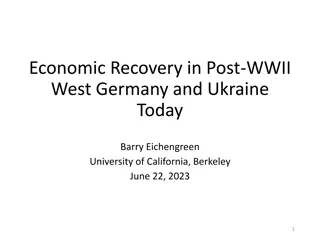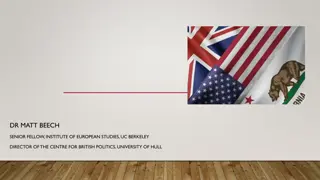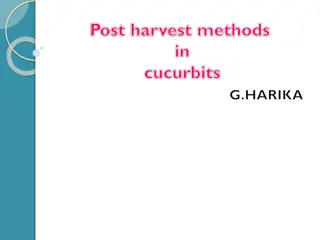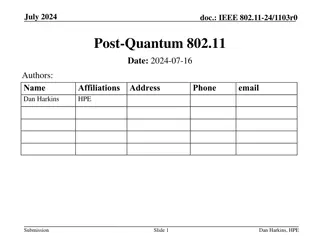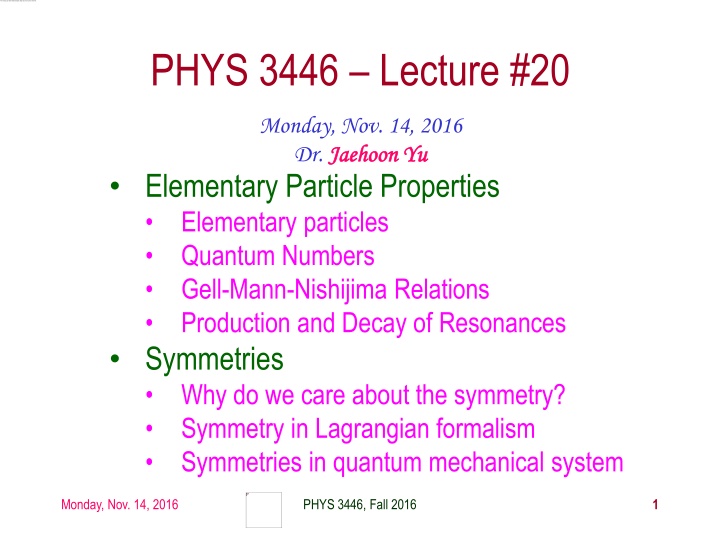
Elementary Particle Properties and Interactions
Explore the fascinating world of elementary particles, including bosons and fermions, their quantum numbers, interactions, and symmetries. Discover the significance of symmetry in Lagrangian formalism and quantum mechanical systems.
Download Presentation

Please find below an Image/Link to download the presentation.
The content on the website is provided AS IS for your information and personal use only. It may not be sold, licensed, or shared on other websites without obtaining consent from the author. If you encounter any issues during the download, it is possible that the publisher has removed the file from their server.
You are allowed to download the files provided on this website for personal or commercial use, subject to the condition that they are used lawfully. All files are the property of their respective owners.
The content on the website is provided AS IS for your information and personal use only. It may not be sold, licensed, or shared on other websites without obtaining consent from the author.
E N D
Presentation Transcript
PHYS 3446 Lecture #20 Monday, Nov. 14, 2016 Dr. Jaehoon Yu Jaehoon Yu Elementary Particle Properties Elementary particles Quantum Numbers Gell-Mann-Nishijima Relations Production and Decay of Resonances Symmetries Why do we care about the symmetry? Symmetry in Lagrangian formalism Symmetries in quantum mechanical system Monday, Nov. 14, 2016 PHYS 3446, Fall 2016 1
Announcements Reading assignments: 10.3 and 10.4 Monday, Nov. 14, 2016 PHYS 3446, Fall 2016 2
Elementary Particles Before the quark concepts, all known elementary particles were grouped in four depending on the nature of their interactions Monday, Nov. 14, 2016 PHYS 3446, Fall 2016 3
Elementary Particles How do these particles interact?? All particles, including photons and neutrinos, participate in gravitational interactions Photons can interact electromagnetically with any particles with electric charge All charged leptons participate in both EM and weak interactions Neutral leptons do not have EM couplings All hadrons (Mesons and baryons) responds to the strong force and appears to participate in all the interactions Monday, Nov. 14, 2016 PHYS 3446, Fall 2016 4
Elementary Particles: Bosons and Fermions All particles can be classified as bosons or fermions Bosons follow Bose-Einstein statistics Quantum mechanical wave function is symmetric under exchange of any pair of bosons ( ) 1 2 3 , , ,... ... B i n x x x x x ( ) = , , ,... . .. x x x x x 2 1 3 B i n xi: space-time coordinates and internal quantum numbers of particle i Fermions obey Fermi-Dirac statistics Quantum mechanical wave function is anti-symmetric under exchange of any pair of Fermions ( ) 1 2 3 , , ,... ... F i n x x x x x ( ) = , , ,... . .. x x x x x 2 1 3 F i n Pauli exclusion principle is built into the wave function For xi=xj, F = F Monday, Nov. 14, 2016 PHYS 3446, Fall 2016 5
Bosons, Fermions, Particles and Antiparticles Bosons All have integer spin angular momentum All mesons are bosons Fermions All have half integer spin angular momentum All leptons and baryons are fermions All particles have anti-particles What are anti-particles? Particles that have the same masses as particles but with opposite charges and quantum numbers What is the anti-particle of A 0? A neutron? A K0? A Neutrinos? 0 n 0 K Monday, Nov. 14, 2016 PHYS 3446, Fall 2016 6
Quantum Numbers When can an interaction occur? If it is kinematically allowed If it does not violate any recognized conservation laws Eg. A reaction that violates charge conservation will not occur In order to deduce conservation laws, a full theoretical understanding of forces are necessary Since we do not have a full theory for all the forces Many of general conservation rules for particles are based on experimental observations One of the clearest conservation rule is the lepton number conservation While photon and meson numbers are not conserved Monday, Nov. 14, 2016 PHYS 3446, Fall 2016 7
Baryon Numbers 0 e + + Can the decay occur? Kinematically?? Yes, proton mass is a lot larger than the sum of the two final state masses Electrical charge? Yes, it is conserved But this decay does not occur (<10-40/sec) Why? Must be a conservation law that prohibits this decay What could it be? An additive and conserved quantum number, the Baryon number (B) All baryons (particles with 3 more quark compositions) have B=1 Anti-baryons? (B=-1) Photons, leptons and mesons have B=0 Since proton is the lightest baryon, it does not decay. p Monday, Nov. 14, 2016 PHYS 3446, Fall 2016 8
Lepton Numbers Quantum number of leptons All leptons carry L=1 (particles) or L=-1 (antiparticles) Photons or hadrons carry L=0 Lepton number is a conserved quantity Total lepton number must be conserved Lepton numbers by species must also be conserved This is an empirical law necessitated by experimental observations (or lack thereof) Consider the decay Does this decay process conserve energy and charge? Yes But it hasn t been observed, why? Due to the lepton number conservation law + + e e Monday, Nov. 14, 2016 PHYS 3446, Fall 2016 9
Lepton Number Assignments Leptons (anti-leptons) e- (e+) Le L L L=Le+L +Lt 1 (-1) 1 (-1) 0 0 0 0 0 0 0 0 0 0 1 (-1) 1 (-1) 1 (-1) 1 (-1) 1 (-1) 1 (-1) ( ) ( e e ) + 1 (-1) 1 (-1) 0 0 ( ( ) ) 1 (-1) 1 (-1) + ( ) Monday, Nov. 14, 2016 PHYS 3446, Fall 2016 10
Lepton Number Conservation Can the following decays occur? + Decays e + + + + + e e e e e + 1 1 1 + 1 1 0 + + + Le L L 0 1 0 0 0 1 0 0 1 + + 0 0 0 + + + + 1 0 0 1 0 0 0 + + + 0 0 0 0 0 0 0 0 L=Le+L +L 1 1 1 1 1 1 1 + + 1 1 1 0 Case 1: L is conserved but Le and L not conserved Case 2: L is conserved but Le and L not conserved Case 3: L is conserved, and Le and L are also conserved Monday, Nov. 14, 2016 PHYS 3446, Fall 2016 11
Quantum Numbers Baryon Number (B) The additive and conserved quantum number assigned to baryons All baryons have B=1 Anti-baryons have B= -1 Photons, leptons and mesons have B=0 Lepton Number The quantum number assigned to leptons All leptons carry L=1 (particles) or L=-1 (antiparticles) Photons or hadrons carry L=0 Total lepton number must be conserved Lepton numbers by species must be conserved Monday, Nov. 14, 2016 PHYS 3446, Fall 2016 12
Strangeness From cosmic ray shower observations K-mesons and & 0 baryons are produced strongly w/ large x-sec s But their lifetimes are typical of weak interactions (~10-10 sec) They are produced in pairs a K with a or a K with a 0 Gave an indication of a new quantum number Consider the reaction K0 and 0 subsequently decay and Observations on 0 Always produced with a K0 never with just a 0 Produced with a K+ but not with a K- 0 p K + + + + 0 0 K + p + + 0 K + 0 p + + + 0 0 + + + + + + p K p Monday, Nov. 14, 2016 PHYS 3446, Fall 2016 13




